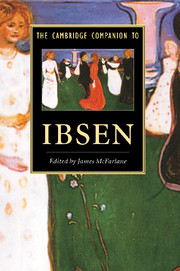Book contents
- Frontmatter
- 1 Ibsen's dramatic apprenticeship
- 2 Ibsen and historical drama
- 3 Dramatic and non-dramatic poetry
- 4 Ibsen and comedy
- 5 Ibsen and the realistic problem drama
- 6 Ibsen and feminism
- 7 The middle plays
- 8 The last plays
- 9 Ibsen's working methods
- 10 Ibsen and the theatre 1877-1900
- 11 Ibsen and the twentieth-century stage
- 12 Ibsen on film and television
- 13 On staging Ibsen
- 14 Ibsen and the drama of today
- 15 A century of Ibsen criticism
- 16 Works of reference
- Index
9 - Ibsen's working methods
Published online by Cambridge University Press: 28 May 2006
- Frontmatter
- 1 Ibsen's dramatic apprenticeship
- 2 Ibsen and historical drama
- 3 Dramatic and non-dramatic poetry
- 4 Ibsen and comedy
- 5 Ibsen and the realistic problem drama
- 6 Ibsen and feminism
- 7 The middle plays
- 8 The last plays
- 9 Ibsen's working methods
- 10 Ibsen and the theatre 1877-1900
- 11 Ibsen and the twentieth-century stage
- 12 Ibsen on film and television
- 13 On staging Ibsen
- 14 Ibsen and the drama of today
- 15 A century of Ibsen criticism
- 16 Works of reference
- Index
Summary
From the very start of his career, Henrik Ibsen learned the compulsions of working to a rigorous deadline. When in the autumn of 1851 he was offered a post at the newly established theatre in Bergen, his contract stipulated that he was to 'assist the theatre as dramatic author'. The unwritten assumption was that he would be expected to come forward with an original dramatic work, all ready and rehearsed for performance, every 2 January - the anniversary of the founding of the theatre. This, as he soon discovered, was to be achieved alongside a punishing regime of daily practical work in the theatre as 'Instructeur'.
His first 'anniversary' occasion, on 2 January 1852, clearly allowed him insufficient time to compose a new full-scale dramatic work; but he did go some way towards meeting his obligations by writing a 'Prologue', partly in rhymed and partly in unrhymed verse, the sentiments of which placed the young author very firmly behind the nationalistic endeavours of the new theatre [i, 619-20].
The succeeding five anniversary occasions — and the nature and quality of the works performed — clearly testify that during these years Ibsen found himself having to work at the composition of his dramas under severe time pressure. On the first of these, in 1853, St John's Night flopped, running for only two performances; although at the time he was quite ready to acknowledge the play as having come from his pen, in later life he tried to disown it [see i, 686].
- Type
- Chapter
- Information
- The Cambridge Companion to Ibsen , pp. 155 - 164Publisher: Cambridge University PressPrint publication year: 1994



